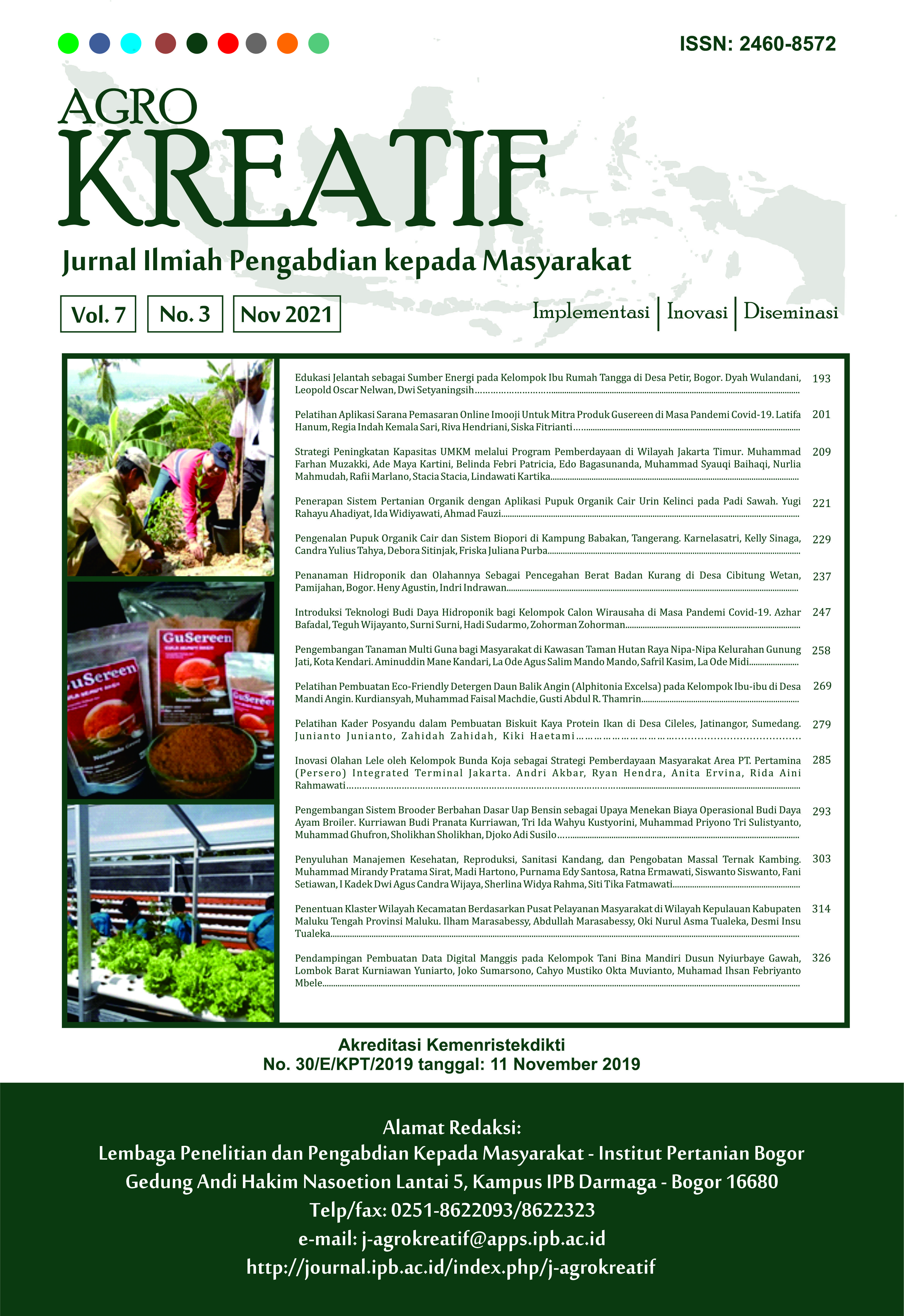Pelatihan Pembuatan Eco-Friendly Detergen Daun Balik Angin (Alphitonia Excelsa) pada Kelompok Ibu-ibu di Desa Mandi Angin
Abstract
Special Purpose Forest Area (KHDTK) Lambung Mangkurat University is a forest area with types of plants and trees. KHDTK is close to residential areas. The existence of community activities around KHDTK will indirectly have an impact on the sustainability of KHDTK. The community activities that impact KHDTK are bathing, washing, and latrine activities (MCK). This community activity provides insight into the impact of using chemical detergents on health and the environment, as well as increasing community empowerment around the KHDTK area in processing natural resources in the form of processing leaves into environmentally friendly detergents. The implementation method consists of two steps, the first step is counseling, and the second step is the preparation of eco-friendly detergents. Counseling carried out by providing knowledge about the impact of synthetic detergents and the manufacture of environmentally friendly detergents. In this activity, the active ingredients used are balik angin leaves because these leaves contain saponins. Leaves balik angin extraction using the infusion method. The results of the evaluation of the activities showed an increase in public knowledge about the impact of synthetic detergents on the environment and an increase in community skills in making environmentally friendly detergents. This activity is very useful in increasing the knowledge and skills of the community.
Downloads
References
Ehilen OE, Obadoni BO, Imade FN, Eseigbe D, Mensah JK. 2017. The effect of detergents on the germination and growth of Amaranthus hybridus L. and Solanum lycopersicon L. Nigerian Annals of Natural Sciences. 16(1): 100–108.
Haderiah H, Dewi NU. 2016. Meminimalisir kadar detergen dengan penambahan koagulan dan filtrasi media saring pada limbah kamar mandi. HIGIENE: Jurnal Kesehatan Lingkungan. 1(1): 33–41.
Helmy Q, Gustiani S, Mustikawati AT. 2020. Application of rhamnolipid biosurfactant for bio-detergent formulation. In: IOP Conference Series: Materials Science and Engineering. 823(1): 012–014. https://doi.org/10.1088/1757-899X/823/1/012014
Hendra H, Barlian, Razak A, Sanjaya H. 2016. Photo-degradation of surfactant compounds using UV rays with addition of tio2 catalysts in laundry waste. Sainstek: Jurnal Sains dan Teknologi. 7(1): 59–68. https://doi.org/10.31958/js.v7i1.126
Nurzaman F, Djajadisastra J, Elya B. 2018. Identifikasi kandungan saponin dalam ekstrak kamboja merah (Plumeria rubra L.) dan daya surfaktan dalam sediaan kosmetik. Jurnal Kefarmasian Indonesia. 8(2): 85–93. https://doi.org/10.22435/jki.v8i2.325
Purnamasari EN. 2014. Karakteristik kandungan linear alkyl benzene sulfonat (LAS) pada limbah cair laundry. Jurnal Media Teknik. 11(1): 32–36.
Rachmawati PA. 2019. Biodegradable Detergen Dari Saponin Daun Waru Dan Ekstraksi Bunga Tanjung. Indonesian Chemistry and Application Journal. 2(2): 1–4. https://doi.org/10.26740/ icaj.v2n2.p1-4
Santi SS. 2009. Penurunan konsentrasi surfactan pada limbah detergen dengan proses photokatalitik sinar UV. Jurnal Teknik Kimia. 4(1): 260–264.
Suastuti DA, Suarsa IW, Putra DK. 2015. Pengolahan larutan detergen dengan biofilter tanaman kangkung (ipomoea crassicaulis) dalam sistem batch (curah) teraerasi. Jurnal Kimia FMIPA. 9(1): 98–104.
Supandi L, Setiawan DA. 2019. Pemanfaatan daun waru (Hibiscus tiliance L) sebagai bahan baku detergen. Sainteks: Jurnal Sains dan Teknik. 1(1): 17–28. https://doi.org/10.37577/sainteks.v1i1.107
Song SS, Zhu LZ, Zhou WJ. 2008. Simultaneous removal of phenanthrene and cadmium from contaminated soils by saponin, a plant-derived biosurfactants. Environmental Pollution. 156: 1368–1370. https://doi.org/10.1016/j.envpol.2008.06.018
Tmáková L, Sekretár S, Schmidt Š. 2016. Plant-derived surfactants as an alternative to synthetic surfactants: surface and antioxidant activities. Chemical Papers. 70(2): 188–196. https://doi.org/10.1515/chempap-2015-0200
Wisetkomolmat J, Suppakittpaisarn P, Sommano S. 2019. Detergent plants of northern thailand: potential sources of natural saponins. Resources. 8(1): 1‒14. https://doi.org/10.3390/resources8010010
Yahaya T, Okpuzor J, Oladele EO. 2011. Investigation of toxicity of detergents. Journal of Environmental Science and Technology. 4(6): 638–645. https://doi.org/10.3923/jest.2011.638.645
This work is licensed under a Creative Commons Attribution-NonCommercial 4.0 International License.



















